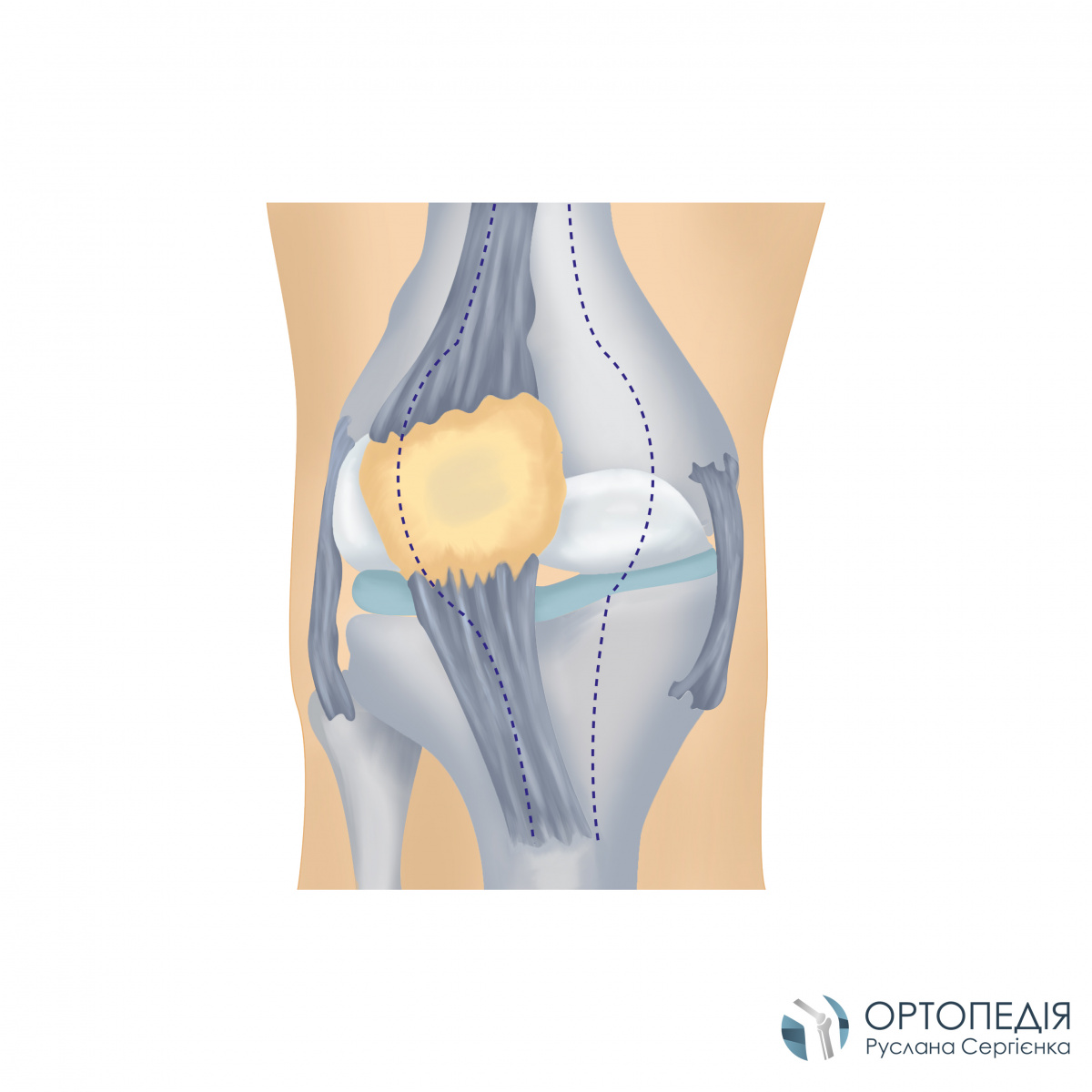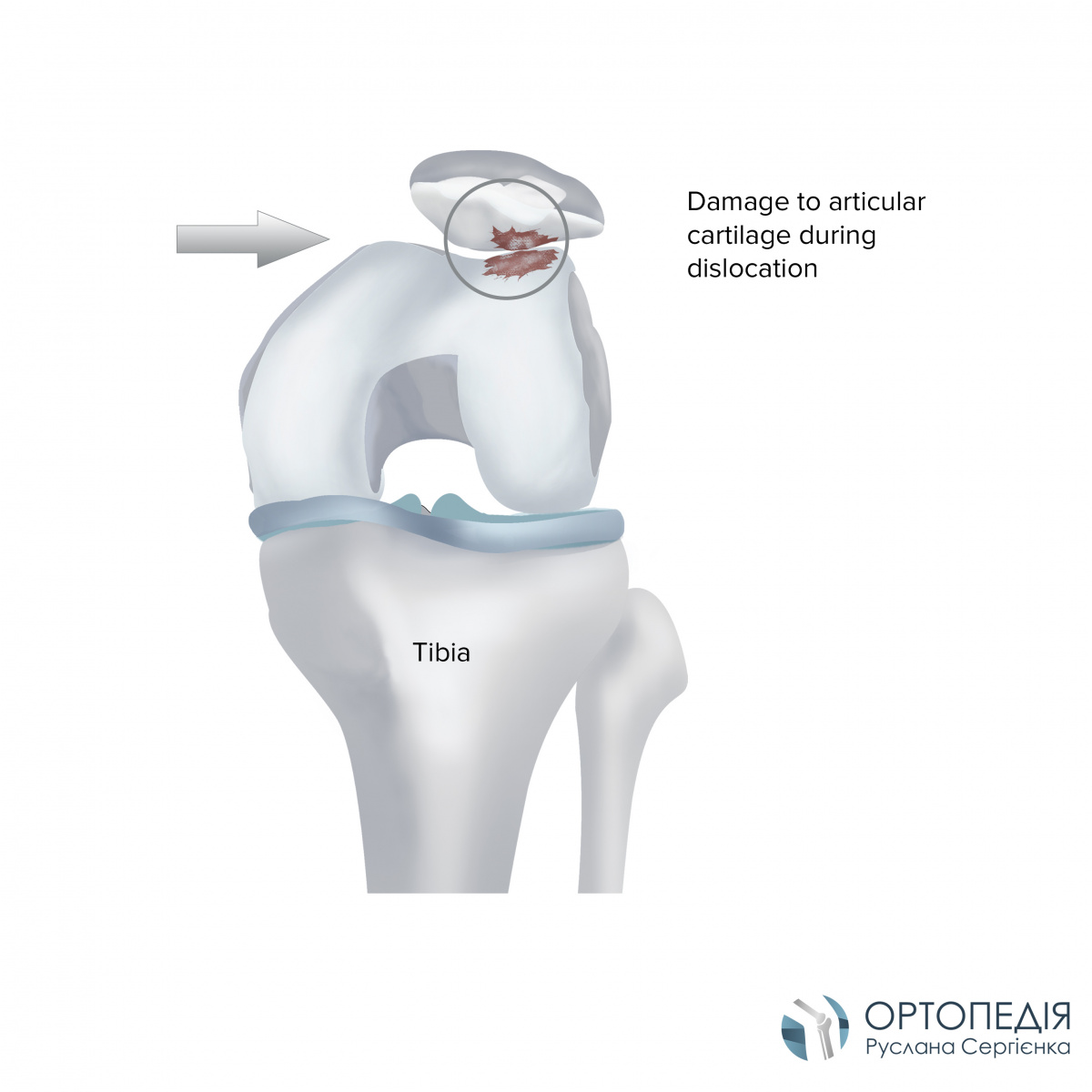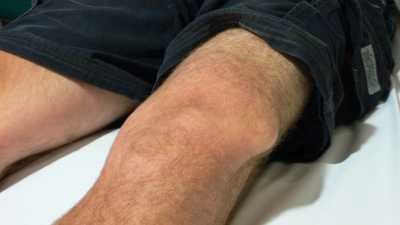Habitual dislocation of the patella
A full range of orthopedic services, from diagnosis to full recovery
The patella, or patella, is a small oval bone that is located above the condyle of the femur in front and at the top of the knee.

Dislocation of the patella (patella) is a common injury in adolescents. Treatment is possible with the help of rehabilitation or surgery.
Causes of patellar dislocation
One of the most common causes of pain in the patellofemoral joint is a violation of the movement of the patella in the interstitial sulcus. The heads of the quadriceps and ligaments help center the patella in the inter-condylar furrow of the femur during movement. For various reasons, an imbalance in the traction of the muscles is possible, as a result of which one of the heads pulls the patella more strongly than the other. This in turn causes a large pressure of the patella on the articular cartilage of the interstitial sulcus on one side compared to the other. Constant asymmetric pressure leads to damage to the articular cartilage. At the same time, the cartilage in the outer part experiences more pressure when moving. If such an effect occurs for a long time, first begins softening, and then the destruction of the cartilage. This phenomenon is called chondromalacia patella.

Finally, patellar dislocation can occur if one of the walls of the inter-condylar sulcus (often the outer one) is less developed than the inner one, or the depth of the inter-condylar sulcus is not sufficient to keep the knee from dislocating. In these cases, the patella also tends to dislocate from the joint. With repeated dislocations, rapid degeneration of the cartilage of the femur and patella occurs and causes a persistent pain syndrome in the patient. It is worth noting that dislocations and subluxations tend to recur, as the surrounding ligaments supporting the patella are stretched or damaged, and the femoral condyles are erased. Complications of patellar dislocation can be considered subchondral fractures.

Conservative treatment
After a dislocation of the patella, the main goal of treatment is to return the knee joint to normal functioning and restore its strength to avoid repeated dislocations of the patella.
In case of traumatic dislocation, it is necessary to release the knee joint from blood and provide it with rest. It is recommended to apply cold. After a few days, rehabilitation begins, the purpose of which is to restore the normal functioning of the knee and the breadth of the range of motion. At the initial stage, it is recommended to use a fixing knee pad. The main goal of rehabilitation is to strengthen the extensor muscles of the thigh, as the straightening force of the knee passes through the kneecap.
In some patients, the recovery process occurs due to proper rehabilitation, i.e. through conservative treatment. Other patients may still have problems, of which the most unpleasant is repeated dislocations of the patella. The frequency of patellar dislocation is different: from 1-2 times a year to several times a day. This can provoke the development of patello-femoral arthrosis in the knee joint and, in addition, dramatically reduces the quality of life. Repeated dislocations need to be treated surgically.
Surgical treatment
During the operation, the task becomes to restore the ligament located on the inside of the patella and femur, which was torn during dislocation. This relatively simple operation is very effective: a result that can be considered good or very good is achieved in more than 90% of cases.
ENTRUST THE CARE OF YOUR HEALTH TO REAL PROFESSIONALS!

Dislocation of the patella (patella) is a common injury in adolescents. Treatment is possible with the help of rehabilitation or surgery.
Causes of patellar dislocation
One of the most common causes of pain in the patellofemoral joint is a violation of the movement of the patella in the interstitial sulcus. The heads of the quadriceps and ligaments help center the patella in the inter-condylar furrow of the femur during movement. For various reasons, an imbalance in the traction of the muscles is possible, as a result of which one of the heads pulls the patella more strongly than the other. This in turn causes a large pressure of the patella on the articular cartilage of the interstitial sulcus on one side compared to the other. Constant asymmetric pressure leads to damage to the articular cartilage. At the same time, the cartilage in the outer part experiences more pressure when moving. If such an effect occurs for a long time, first begins softening, and then the destruction of the cartilage. This phenomenon is called chondromalacia patella.

Finally, patellar dislocation can occur if one of the walls of the inter-condylar sulcus (often the outer one) is less developed than the inner one, or the depth of the inter-condylar sulcus is not sufficient to keep the knee from dislocating. In these cases, the patella also tends to dislocate from the joint. With repeated dislocations, rapid degeneration of the cartilage of the femur and patella occurs and causes a persistent pain syndrome in the patient. It is worth noting that dislocations and subluxations tend to recur, as the surrounding ligaments supporting the patella are stretched or damaged, and the femoral condyles are erased. Complications of patellar dislocation can be considered subchondral fractures.

Conservative treatment
After a dislocation of the patella, the main goal of treatment is to return the knee joint to normal functioning and restore its strength to avoid repeated dislocations of the patella.
In case of traumatic dislocation, it is necessary to release the knee joint from blood and provide it with rest. It is recommended to apply cold. After a few days, rehabilitation begins, the purpose of which is to restore the normal functioning of the knee and the breadth of the range of motion. At the initial stage, it is recommended to use a fixing knee pad. The main goal of rehabilitation is to strengthen the extensor muscles of the thigh, as the straightening force of the knee passes through the kneecap.
In some patients, the recovery process occurs due to proper rehabilitation, i.e. through conservative treatment. Other patients may still have problems, of which the most unpleasant is repeated dislocations of the patella. The frequency of patellar dislocation is different: from 1-2 times a year to several times a day. This can provoke the development of patello-femoral arthrosis in the knee joint and, in addition, dramatically reduces the quality of life. Repeated dislocations need to be treated surgically.
Surgical treatment
During the operation, the task becomes to restore the ligament located on the inside of the patella and femur, which was torn during dislocation. This relatively simple operation is very effective: a result that can be considered good or very good is achieved in more than 90% of cases.
ENTRUST THE CARE OF YOUR HEALTH TO REAL PROFESSIONALS!
Photo gallery:
Product rating is: 0 from 5
Please rate the product:
Advantages of treatment in Orthopedics by Ruslan Sergienko
-
10 years on medical services in Ukraine
-
> 25 years of experience with leading specialists
-
Anna Vovchenko and Ruslan Sergienko are recognized opinion leaders among the orthopedic traumatologists
-
> 150,000 consultations were held
-
> 7,500 surgeries were performed
-
All types of pain management
-
The operating unit is equipped according to international standards
-
Availability of all medicines and supplies
-
Single rooms, equipped with the characteristics of orthopedic patients
-
Three meals a day
-
Postoperative rehabilitation by certified specialists
-
Pricing Transparency
